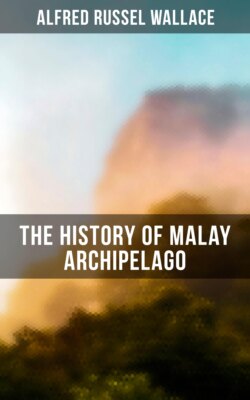The History of Malay Archipelago

Реклама. ООО «ЛитРес», ИНН: 7719571260.
Оглавление
Alfred Russel Wallace. The History of Malay Archipelago
The History of Malay Archipelago
Table of Contents
VOLUME 1
Table of Contents
PREFACE
CHAPTER I. PHYSICAL GEOGRAPHY
CHAPTER II. SINGAPORE
CHAPTER III. MALACCA AND MOUNT OPHIR
CHAPTER IV. BORNEO—THE ORANGUTAN
CHAPTER V. BORNEO—JOURNEY INTO THE INTERIOR
CHAPTER VI. BORNEO—THE DYAKS
CHAPTER VII. JAVA
CHAPTER VIII. SUMATRA
CHAPTER IX. NATURAL HISTORY OF THE INDO-MALAY ISLANDS
CHAPTER X. BALI AND LOMBOCK
CHAPTER XI. LOMBOCK: MANNERS AND CUSTOMS OF THE PEOPLE
CHAPTER XII. LOMBOCK: HOW THE RAJAH TOOK THE CENSUS
CHAPTER XIII. TIMOR
CHAPTER XIV. THE NATURAL HISTORY OF THE TIMOR GROUP
CHAPTER XV. CELEBES
CHAPTER XVI. CELEBES
CHAPTER XVII. CELEBES
CHAPTER XVIII. NATURAL HISTORY OF CELEBES
CHAPTER XIX. BANDA
CHAPTER XX. AMBOYNA
VOLUME 2
Table of Contents
CHAPTER XXI. THE MOLUCCAS—TERNATE
CHAPTER XXII. GILOLO
CHAPTER XXIII. TERNATE TO THE KAIOA ISLANDS AND BATCHIAN
CHAPTER XXIV. BATCHIAN
CHAPTER XXV. CERAM, GORAM, AND THE MATABELLO ISLANDS
CHAPTER XXVI. BOURU
CHAPTER XXVII. THE NATURAL HISTORY OF THE MOLUCCAS
CHAPTER XXVIII. MACASSAR TO THE ARU ISLANDS IN A NATIVE PRAU
CHAPTER XXIX. THE KE ISLANDS
CHAPTER XXX. THE ARU ISLANDS—RESIDENCE IN DOBBO
CHAPTER XXXI. THE ARU ISLANDS.—JOURNEY AND RESIDENCE IN THE INTERIOR
CHAPTER XXXII. THE ARU ISLANDS.—SECOND RESIDENCE AT DOBBO
CHAPTER XXXIII. THE ARU ISLANDS—PHYSICAL GEOGRAPHY AND ASPECTS OF
CHAPTER XXXIV. NEW GUINEA.—DOREY
CHAPTER XXXV. VOYAGE FROM CERAM TO WAIGIOU
CHAPTER XXXVI. WAIGIOU
CHAPTER XXXVII. VOYAGE FROM WAIGIOU TO TERNATE
CHAPTER XXXVIII. THE BIRDS OF PARADISE
CHAPTER XXXIX. THE NATURAL HISTORY OF THE PAPUAN ISLANDS
CHAPTER XL. THE RACES OF MAN IN THE MALAY ARCHIPELAGO
Отрывок из книги
Alfred Russel Wallace
Published by
.....
The inference that we must draw from these facts is, undoubtedly, that the whole of the islands eastwards beyond Java and Borneo do essentially form a part of a former Australian or Pacific continent, although some of them may never have been actually joined to it. This continent must have been broken up not only before the Western Islands were separated from Asia, but probably before the extreme southeastern portion of Asia was raised above the waters of the ocean; for a great part of the land of Borneo and Java is known to be geologically of quite recent formation, while the very great difference of species, and in many cases of genera also, between the productions of the Eastern Malay Islands and Australia, as well as the great depth of the sea now separating them, all point to a comparatively long period of isolation.
It is interesting to observe among the islands themselves how a shallow sea always intimates a recent land connexion. The Aru Islands, Mysol, and Waigiou, as well as Jobie, agree with New Guinea in their species of mammalia and birds much more closely than they do with the Moluccas, and we find that they are all united to New Guinea by a shallow sea. In fact, the 100-fathom line round New Guinea marks out accurately the range of the true Paradise birds.
.....